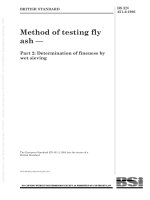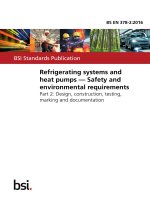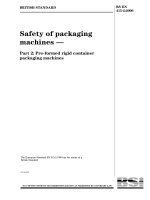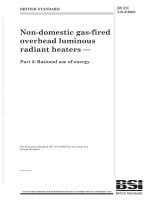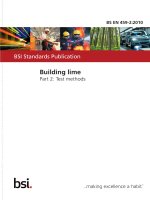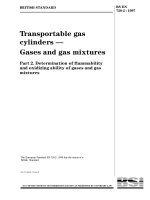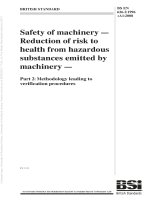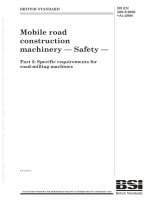Bsi bs en 16704 2 2 2016
Bạn đang xem bản rút gọn của tài liệu. Xem và tải ngay bản đầy đủ của tài liệu tại đây (7.42 MB, 34 trang )
BS EN 16704-2-2:2016
BSI Standards Publication
Railway applications — Track —
Safety protection on the track
during work
Part 2-2: Common solutions and
technology — Requirements for barriers
BS EN 16704-2-2:2016
BRITISH STANDARD
National foreword
This British Standard is the UK implementation of EN
16704-2-2:2016.
The UK participation in its preparation was entrusted to Technical
Committee RAE/2, Railway Applications - Track.
A list of organizations represented on this committee can be
obtained on request to its secretary.
This publication does not purport to include all the necessary
provisions of a contract. Users are responsible for its correct
application.
© The British Standards Institution 2016.
Published by BSI Standards Limited 2016
ISBN 978 0 580 83487 5
ICS 93.100
Compliance with a British Standard cannot confer immunity from
legal obligations.
This British Standard was published under the authority of the
Standards Policy and Strategy Committee on 30 November 2016.
Amendments/Corrigenda issued since publication
Date
Text affected
BS EN 16704-2-2:2016
EN 16704-2-2
EUROPEAN STANDARD
NORME EUROPÉENNE
EUROPÄISCHE NORM
November 2016
ICS 93.100
English Version
Railway applications - Track - Safety protection on the
track during work - Part 2-2: Common solutions and
technology - Requirements for barriers
Applications ferroviaires - Voie - Protection et sécurité
durant des travaux sur la voie - Partie 2-2: Solutions
communes et technologie - Exigences relatives aux
barrières
Bahnanwendungen - Oberbau - Sicherungsmaßnahmen
während Gleisbauarbeiten - Teil 2-2: Allgemeine
Lösungen und Technologie - Anforderungen an
Absperrungen
This European Standard was approved by CEN on 6 August 2016.
CEN members are bound to comply with the CEN/CENELEC Internal Regulations which stipulate the conditions for giving this
European Standard the status of a national standard without any alteration. Up-to-date lists and bibliographical references
concerning such national standards may be obtained on application to the CEN-CENELEC Management Centre or to any CEN
member.
This European Standard exists in three official versions (English, French, German). A version in any other language made by
translation under the responsibility of a CEN member into its own language and notified to the CEN-CENELEC Management
Centre has the same status as the official versions.
CEN members are the national standards bodies of Austria, Belgium, Bulgaria, Croatia, Cyprus, Czech Republic, Denmark, Estonia,
Finland, Former Yugoslav Republic of Macedonia, France, Germany, Greece, Hungary, Iceland, Ireland, Italy, Latvia, Lithuania,
Luxembourg, Malta, Netherlands, Norway, Poland, Portugal, Romania, Slovakia, Slovenia, Spain, Sweden, Switzerland, Turkey and
United Kingdom.
EUROPEAN COMMITTEE FOR STANDARDIZATION
COMITÉ EUROPÉEN DE NORMALISATION
EUROPÄISCHES KOMITEE FÜR NORMUNG
CEN-CENELEC Management Centre: Avenue Marnix 17, B-1000 Brussels
© 2016 CEN
All rights of exploitation in any form and by any means reserved
worldwide for CEN national Members.
Ref. No. EN 16704-2-2:2016 E
BS EN 16704-2-2:2016
EN 16704-2-2:2016 (E)
Contents
Page
European foreword....................................................................................................................................................... 3
Introduction .................................................................................................................................................................... 4
1
Scope .................................................................................................................................................................... 5
2
Normative references .................................................................................................................................... 5
3
Terms and definitions ................................................................................................................................... 6
4
Specification of barriers ............................................................................................................................... 8
5
5.1
5.2
5.3
5.4
5.5
5.6
5.7
5.7.1
5.7.2
5.7.3
5.7.4
Requirements for barriers........................................................................................................................... 9
General ................................................................................................................................................................ 9
Horizontal components ............................................................................................................................. 10
Mounting of horizontal components at different transversal distances.................................. 10
Extendable devices ...................................................................................................................................... 11
Track gauge requirements ....................................................................................................................... 11
Height ............................................................................................................................................................... 11
Material............................................................................................................................................................ 14
General ............................................................................................................................................................. 14
Special requirements for steel ................................................................................................................ 14
Special requirements for timber ............................................................................................................ 14
Material for weights and counterweights ........................................................................................... 14
6
6.1
6.2
6.3
6.4
6.4.1
6.4.2
6.4.3
6.4.4
6.4.5
6.5
6.6
6.6.1
6.6.2
6.6.3
6.6.4
6.7
6.8
6.9
Test methods for stability requirements ............................................................................................ 14
General ............................................................................................................................................................. 14
Applying the loads ....................................................................................................................................... 14
Description of sample erection ............................................................................................................... 15
Tests for conformity with load requirements ................................................................................... 16
General ............................................................................................................................................................. 16
Tests for deflection ...................................................................................................................................... 16
Oscillation ....................................................................................................................................................... 20
Vibrations ....................................................................................................................................................... 21
Aerodynamics ................................................................................................................................................ 21
Nets and protective plates ........................................................................................................................ 22
Electrical requirements ............................................................................................................................. 22
General requirements ................................................................................................................................ 22
Electrical resistance for horizontal components (guard rails) ................................................... 22
Electrical resistance for vertical components (post) ...................................................................... 22
Electrical requirements for 3rd rail ...................................................................................................... 22
Marking ............................................................................................................................................................ 22
Test reports .................................................................................................................................................... 23
Additional requirements for barriers in case of 3rd rail ............................................................... 23
7
Requirements for marking (visual demarcation line) ................................................................... 24
8
System approval ........................................................................................................................................... 24
9
User manual ................................................................................................................................................... 24
Annex A (informative) Special national conditions ...................................................................................... 26
Annex B (informative) Operational distance of barriers ............................................................................ 28
Bibliography ................................................................................................................................................................. 29
2
BS EN 16704-2-2:2016
EN 16704-2-2:2016 (E)
European foreword
This document (EN 16704-2-2:2016) has been prepared by Technical Committee CEN/TC 256 “Railway
applications”, the secretariat of which is held by DIN.
This European Standard shall be given the status of a national standard, either by publication of an
identical text or by endorsement, at the latest by May 2017, and conflicting national standards shall be
withdrawn at the latest by May 2017.
Attention is drawn to the possibility that some of the elements of this document may be the subject of
patent rights. CEN shall not be held responsible for identifying any or all such patent rights.
This document has been prepared under a mandate given to CEN by the European Commission and the
European Free Trade Association.
This European Standard is one of the series EN 16704 “Railway applications – Track – Safety protection
on the track during work” as listed below:
— Part 1: Railway risks and common principles for protection of fixed and mobile work sites
— Part 2-1: Common solutions and technology – Technical requirements for Track Warning Systems
(TWS)
— Part 2-2: Common solutions and technology – Technical requirements for barriers
— Part 3: Competences of personnel related to work on or near tracks
According to the CEN-CENELEC Internal Regulations, the national standards organisations of the
following countries are bound to implement this European Standard: Austria, Belgium, Bulgaria,
Croatia, Cyprus, Czech Republic, Denmark, Estonia, Finland, Former Yugoslav Republic of Macedonia,
France, Germany, Greece, Hungary, Iceland, Ireland, Italy, Latvia, Lithuania, Luxembourg, Malta,
Netherlands, Norway, Poland, Portugal, Romania, Slovakia, Slovenia, Spain, Sweden, Switzerland,
Turkey and the United Kingdom.
3
BS EN 16704-2-2:2016
EN 16704-2-2:2016 (E)
Introduction
The purpose of this standard is to define and harmonize requirements for barriers to separate working
zone and danger zone and to prevent workers from entering the danger zone unintentionally.
The purpose of this standard is not to define requirements:
— for structural separation to provide safe train operation in the area of a work site(1);
— for structural separation to provide safety on a work site during train operation(2).
NOTE
Examples for exclusions:
(2)
A barrier does not protect workers from items falling from passing trains.
(1)
In case of crane operation on a work site the crane arm could hit or even intrude into the gauge of an
open track and endanger the safety of train operation.
4
BS EN 16704-2-2:2016
EN 16704-2-2:2016 (E)
1 Scope
This European Standard deals with requirements for barriers to give users the possibility to prevent
workers from entering the danger zone unintentionally by the use of such barriers.
This standard defines minimum requirements and test procedures for these barriers concerning the
dimensions, the stability and electrical properties.
This standard also gives recommendations for the marking (visual demarcation line) where a person
would enter the danger zone.
For combinations of barriers and TWS see also EN 16704-2-1:2016.
This standard contains references to electrical hazards from third rail systems.
NOTE
Urban rail systems do have the same situations but may have other individual track gauges. EN 16704–
1 does not cover Urban rail systems. The use of barriers as a safety measure has the same intention independently
of the kind of railway system.
This standard in particular does not deal with:
— risk assessment for safety protection on the track during work;
— hierarchy of safety measure for safety protection on the track during work;
— safety measure to provide safe working and safe train operation in the area of a work site;
— national safety regulations to plan and operate barriers in track;
— safety regulations and additional requirements e.g. due to national or operational rules or
negotiation between the user and the manufacturer;
— electrical hazards by different potential of different electrified circuits.
2 Normative references
The following documents, in whole or in part, are normatively referenced in this document and are
indispensable for its application. For dated references, only the edition cited applies. For undated
references, the latest edition of the referenced document (including any amendments) applies.
EN 364:1992, Personal protective equipment against falls from a height - Test methods
EN 1263-1, Temporary works equipment - Safety nets - Part 1: Safety requirements, test methods
EN 12811-2, Temporary works equipment - Part 2: Information on materials
EN 12811-3:2002, Temporary works equipment - Part 3: Load testing
EN 13374:2013, Temporary edge protection systems - Product specification - Test methods
EN 14067-4, Railway applications - Aerodynamics - Part 4: Requirements and test procedures for
aerodynamics on open track
EN 50110-1, Operation of electrical installations - Part 1: General requirements
EN 50110-2, Operation of electrical installations - Part 2: National annexes
5
BS EN 16704-2-2:2016
EN 16704-2-2:2016 (E)
EN 50122-1, Railway applications - Fixed installations - Electrical safety, earthing and the return circuit Part 1: Protective provisions against electric shock
EN 50122-2, Railway applications - Fixed installations - Electrical safety, earthing and the return circuit Part 2: Provisions against the effects of stray currents caused by d.c. traction systems
EN 50122-3, Railway applications - Fixed installations - Electrical safety, earthing and the return circuit Part 3: Mutual Interaction of a.c. and d.c. traction systems
EN 50125-3:2003, Railway applications - Environmental conditions for equipment - Part 3: Equipment for
signalling and telecommunications
EN ISO 13857, Safety of machinery - Safety distances to prevent hazard zones being reached by upper and
lower limbs (ISO 13857)
3 Terms and definitions
For the purposes of this document the following terms and definitions apply.
3.1
danger zone
area where a person, material or equipment can be struck by a railway vehicle or exposed to injury or
fatality due to wind drag
3.2
separation
method to keep apart the working zone and the danger zone of the adjacent track/operational track and
to prevent workers from entering unintentionally into the danger zone
Note 1 to entry:
Measures of separation are barriers, (steel) walls, work wagons, etc.
3.3
visible separation
marking of the beginning of the danger zone by visual demarcation lines e.g. by bands
3.4
preventive separation
separation that prevents unintentional entering of workers into the danger zone e.g. by a barrier
3.5
barrier
common technical solution to realize preventive separation by a set of components to separate working
zone and danger zone and to prevent workers from entering the danger zone unintentionally
3.6
marking/visual demarcation line
common technical solution to achieve limited separation by marking (visual demarcation line) of where
a person would enter the danger zone
Note 1 to entry
Separation by marking (visual demarcation line) is not an autonomous and independent
measure for safety protection on the track during work (see Clause 8).
6
BS EN 16704-2-2:2016
EN 16704-2-2:2016 (E)
3.7
module
smallest entity of a barrier consisting of fixing and extendable devices, vertical and horizontal
components (to be defined by the manufacturer in the manual)
3.8
extendable device
adjustable component to realize different distances to the track or different heights above the rail
3.9
principal guardrail / upper horizontal component
continuous horizontal component forming the top of the barrier
3.10
intermediate guardrail/intermediate horizontal component
guardrail positioned between the principal guardrail and the working surface
3.11
intermediate protection
protection barrier formed (e.g. as a fencing structure or a safety net) between the principal guardrail
and the working surface
3.12
post/vertical component
principal vertical component to which horizontal components are attached
3.13
axis
axis used in this standard are explained in Figure 1
Key
1
2
3
4
5
vertical
longitudinal, horizontal
transversal
rail
sleeper/bearer/slab
track
Figure 1 — Track section plus position name and three axes
7
BS EN 16704-2-2:2016
EN 16704-2-2:2016 (E)
4 Specification of barriers
For the purposes of this document the following specifications apply.
Table 1 — Specification of parameters for barriers
type
requirement
clause
max. length of components
5.1
min./max height
static stability test-load
max. deflection δ
dynamic stability
(oscillation)
dynamic stability
(vibration)
dynamic stability
(aerodynamic)
electric requirements
3rd rail hazards
marking
5.6
6.4.2.2.1
6.4.2.2.2
6.4.2.2.3
6.4.3
6.4.4
6.4.5
6.6
6.9
7
barrier
marking
lmax ≤ 3,20 m
not specified
value or objective
prevention of unintentional
entering into the dangerous
zone
defined by national rules
(see also Annex A)
0,3 kN
50 mm
0,3 kN ➔ 0 kN
2 mm
additional approval
(calculation or testing) for a
speed > 160 km/h
no unintended influence on
the signalling
resistance between
horizontal components: min.
50 kΩ at 500 V AC
resistance between vertical
components: min. 50 kΩ at
500 V AC
structure or net
(max 40 mm mesh) or
other adequate measures
according to the risk analysis
red/white
yellow/black
blue
objective
limitative separation
only, marking of the
border of the danger
zone by a visual
demarcation line
not specified
not specified
not specified
not specified
not specified
not specified
see Clause 7
NOTE
Separation by marking (visual demarcation line) is not an autonomous and independent measure for
safety protection on the track during work (see Clause 7).
8
BS EN 16704-2-2:2016
EN 16704-2-2:2016 (E)
5 Requirements for barriers
5.1 General
Barriers shall comprise at least:
— a principal guardrail, and
— an intermediate guardrail or an intermediate protection (e.g. net, plate, mesh).
The mounting of TWS components on the barrier should be considered by the manufacturer.
Examples for barriers with rail mounted and non-rail mounted fixing are shown in Figure 2.
a) Rail mounted barrier
b) Non-rail mounted barrier
Key
1 ballast
2 sleeper and rail fastening
3 rail
4 rail/track mounted fixing
5 extendable device with vertical components
6 principal guardrail
7 intermediate guardrail
Figure 2 —Examples for a module and components of a barrier
Barriers shall comply with all requirements of Clause 5 up to Clause 8.
All values (e.g. for height or distances) refer to straight horizontal tracks with a gauge of 1435 mm
without rail cant. For other track gauges it is recommended to use Annex B to convert the distance in
Figure 3 to other reference points.
NOTE 1
For special situations (e.g. rail cant, 3rd rail) a risk assessment according to EN 16704–1:2016 may be
required. As a result other and/or additional measures could be necessary.
Barriers shall have no sharp or jagged edges.
Barriers shall be usable on switches and crossings (e.g. by special attachment devices).
Barriers shall be constructed in a way that the track circuit system is not affected and accidental
electrical hazards are minimized (for details see 6.6).
9
BS EN 16704-2-2:2016
EN 16704-2-2:2016 (E)
It shall be possible to mount, position and remove all components easily and:
— preferably from outside of the track, and
— preferably without removing ballast or anti-vibration devices mounted to the rail.
The various associated components shall allow quick assembly and disassembly.
The construction shall allow during use:
— temporary demounting of single modules;
— variation of the distance to the track;
— the removal of horizontal components without a tool in case of emergency.
Components made of electrical non-conductive material shall have a length not exceeding 3,20 m.
Components made of metal or other electrical conductive material shall have a length not exceeding
2,00 m.
NOTE 2
In case of a maximum length of 3,20 m the distance from the track does change only in a range of
f = 1 cm to 2 cm, even in small curves (R = 80 m) [f approximately length2/(8R)].
It shall be possible to adjust the length of a module in a range of 0,4 m minimum (e.g. by adjustable
horizontal components or by variable fixing points for the horizontal components).
5.2 Horizontal components
Principal and intermediate guardrails shall have a minimum cross-section height of 35 mm (see
Figure 4).
If intermediate guardrails are provided, any gap shall be so dimensioned that a sphere of 470 mm
diameter will not pass through the protection. If there are no intermediate guardrails or if it is not
continuous, the intermediate protection shall be so dimensioned that a sphere with a diameter of
250 mm will not pass through it.
5.3 Mounting of horizontal components at different transversal distances
It shall be possible (e.g. by extendable devices) to position the horizontal components at transversal
distances at least at 1,90 m, 2,00 m, 2,10 m, 2,20 m, 2,30 m, 2,40 m and 2,50 m (±20 mm) (see Figure 3)
measured from centre of the track to the inner part of the barrier at the level of the horizontal
components.
10
BS EN 16704-2-2:2016
EN 16704-2-2:2016 (E)
Figure 3 — Necessary possible positions and range of extendable devices
NOTE
Annex B gives formulae to convert these values to other reference points.
5.4 Extendable devices
Extendable devices shall be equipped with a locking device for fixing at the chosen distance [prevention
against accidental variations in length (due to operation and impact, vibrations, etc.)].
Each position of extendable devices shall be marked clearly.
5.5 Track gauge requirements
Barriers including attachment devices shall respect the gauges of the track (for information see series of
standards of EN 15273). For examples of vertical components see Figure 5.
5.6 Height
Barriers shall prevent people from unintentionally entering into the danger zone.
The height of the principal guardrail above the bottom of the rail (hmin) shall be at least 880 mm, but it is
recommended to achieve a min. height hmin of 1000 mm as mentioned in EN 13374. The maximum
height of components above the bottom of rail (hmax) shall be in accordance with Annex A (see also
Figures 4 and 5) after preliminary loads according to 6.4.2.1.
For specific national requirements and rules see also Annex A.
11
BS EN 16704-2-2:2016
EN 16704-2-2:2016 (E)
Dimensions in millimetres
a) Rail mounted barrier
Dimensions in millimetres
b) Non-rail mounted barrier
Figure 4 —Dimension and position of horizontal and vertical components
12
BS EN 16704-2-2:2016
EN 16704-2-2:2016 (E)
Dimensions in millimetres
a) Example for a rail mounted barrier with vertical components in 90° shape
Dimensions in millimetres
b) Example for a rail mounted barrier with components in not perpendicular shape
Dimensions in millimetres
Key
1 reference axis
2 bottom of rail
3 top of rail
c) Non-rail mounted barrier
Figure 5 —Example for different shapes of the extendable devices in different distances to the
middle of the track
13
BS EN 16704-2-2:2016
EN 16704-2-2:2016 (E)
5.7 Material
5.7.1 General
Material shall fulfil the requirements given in European Standards, where design data are provided.
Other materials shall be in accordance with appropriate European Standards. If European Standards do
not exist, ISO standards may be applied.
Materials shall be sufficiently robust and durable to withstand normal working conditions.
Materials shall be free from any impurity and defects, which may affect their satisfactory use.
Information about the most commonly used materials is given in EN 12811-2. Material requirements
for nets are given in EN 1263-1.
For general calculation of the design to pass the testing procedures according to Clause 6 of this
standard, EN 13374 is useful.
5.7.2 Special requirements for steel
Steels of deoxidation type FU (rimming steel) shall not be used.
Information on common types of corrosion protection is given in EN 12811-2.
5.7.3 Special requirements for timber
For the requirements concerning the wood and plywood apply EN 13374:2013, 5.3.3.
5.7.4 Material for weights and counterweights
The materials employed shall be solid. Granulated or fluid materials such as sand or water shall not be
used. Each weight and each counterweight shall be capable of being positively secured against
accidental displacement.
6 Test methods for stability requirements
6.1 General
The test shall be carried out in accordance with the requirements in Clause 6 of this standard, and
additionally relevant European Standards shall be used. Unless otherwise indicated in the following,
testing shall be conducted by way of visual examination and measurement.
Each testing laboratory which carries out the test shall be able to demonstrate competence to carry out
the relevant testing requirements of this standard.
NOTE 1
NOTE 2
Some countries have systems for national accreditation of testing laboratories.
Figures used in Clause 6 to explain the testing procedures of rail mounted barriers are examples only.
6.2 Applying the loads
The loading point shall be maximum 100 mm × 100 mm or with smaller elements, the width of the
element × 100 mm.
When testing nets or fencing structures a distributing plate of maximum 300 mm × 300 mm is required.
Stability of the test rig structure shall comply with EN 364:1992, 4.4 (the natural frequency shall not be
lower than 100 Hz and the deformation shall not exceed 1 mm in the fixing point at a force of 20 kN).
14
BS EN 16704-2-2:2016
EN 16704-2-2:2016 (E)
6.3 Description of sample erection
The test sample shall comprise one module of each type in the length most vulnerable to failure or the
worst possible configuration. Whichever the case the test sample shall be erected to represent the way
it is intended that it would be erected during use on site, i.e. in accordance with the manufacturer's
instructions. For friction (counterweighted) type protection, the surface on which the system is
installed shall be inclined by 10° to the horizontal.
For counter-weighted systems, the test sample shall be erected on a surface according to the
specification of the manufacturer in accordance with his manual.
Dimensions in millimetres.
Key
lmax length of module
Figure 6 —Example of a module
15
BS EN 16704-2-2:2016
EN 16704-2-2:2016 (E)
Table 2 — Tests for static and dynamic stability of barriers
static stability
load type
clause
figure(s)
force
reaction
deflection
vertical
component
horizontal
component
dynamic stability
transversal
load
horizontal
load
vertical load
oscillation and
vibration
aerodynamic
6.4.2.2.1
6.4.2.2.2
6.4.2.2.3
6.4.3
6.4.4
6.4.5
Ft (t)
-
Figure 7
Figure 8
Ft (static)
Figure 9
-
vertical
transversal
-
δv ≤ 50 mm
-
Fv (static)
δh
δv
horizontal
δt ≤ 50 mm
δh ≤ 50 mm
δt ≤ 50 mm
Figure 13
Fh (static)
transversal
δt
Figure 10
Figure 11
Figure 12
-
δt deflection in transversal direction
δh deflection in horizontal direction
δv deflection in vertical direction
δt, osc(t) oscillation amplitude
δv ≤ 50 mm
δt,osc(t)
δt,osc(t) ≤ 1 mm
-
6.4 Tests for conformity with load requirements
6.4.1 General
If appropriate according to EN 13374:2013, 6.1.2, the static load requirements, or parts of them, may be
verified by testing.
Where the most onerous load case cannot be identified, initial tests may be carried out to identify it.
Alternatively, all load cases can be verified.
A minimum of four separate representative samples shall be tested in each type of test.
6.4.2 Tests for deflection
6.4.2.1 Preliminaries
Prior to each test the system shall have a preliminary load of 0,1 kN applied to it. This load is to be held
for one minute and then removed. The position of the system after this shall be the datum for
measurements in the full deflection test described.
NOTE
The purpose of this load is to ensure that the system is properly bedded and that any looseness is
taken out.
16
BS EN 16704-2-2:2016
EN 16704-2-2:2016 (E)
6.4.2.2 Test procedure
6.4.2.2.1 General
The load on the system shall be applied in five regular increments up to the maximum test load. The
maximum test load shall be held for one minute to determine the creep characteristics of the system.
During the loading the load and the instantaneous deflection of the barrier shall be measured and
recorded continually or at each load increment.
6.4.2.2.2 Static stability against transversal load
Principal and intermediate guardrails necessary to fulfil requirements in 5.2 shall be subjected to a
transversal force Ft of 0,3 kN at the most vulnerable point statically applied in both directions normal to
the track. It shall have no visible permanent deformation and the maximum transversal movement δt
shall not be more than 50 mm (see Figure 7).
The vertical component, which is subjected at the top to a transversal force Ft of 0,3 kN, statically
applied in both directions normal to the track, shall have no visible permanent deformation and the
maximum horizontal movement δt shall not be more than 50 mm (see Figure 8).
NOTE
Only one vertical component is subjected to the load Ft, the other vertical component is not loaded.
Figure 7 —Permitted deflection with load at the principal guardrail
17
BS EN 16704-2-2:2016
EN 16704-2-2:2016 (E)
Dimensions in millimetres
Key
1
reference axis
2
bottom of rail
3
top of rail
Figure 8 —Permitted deflection with load at the vertical component
6.4.2.2.3 Static stability against longitudinal/horizontal load
The vertical component which is subjected at the top to a horizontal force Fh of 0,3 kN, statically applied
in both direction parallel to the track, shall have no visible permanent deformation and the maximum
horizontal movement δh shall not be more than 50 mm (see Figure 9).
NOTE
Only one vertical component is subjected to the load Fh, the other vertical component is not loaded.
Figure 9 — Maximum longitudinal movement of the vertical component
18
BS EN 16704-2-2:2016
EN 16704-2-2:2016 (E)
6.4.2.2.4 Static stability against vertical load
The vertical component, which is subjected to a vertical force Fv of 0,3 kN on the top, statically applied,
shall have no visible permanent deformation and the maximum vertical deflection δv shall not be more
than 50 mm (see Figure 10).
NOTE
Only one vertical component is subjected to the load Fv, the other vertical component is not loaded.
The vertical component, which is subjected to a vertical force of 1,2 kN, statically applied at the lowest
outer horizontal part, shall have no visible permanent deformation. During the test a free deflection of
the vertical component at its lowest outer horizontal part of minimum 200 mm shall be possible (see
Figure 11).
Principal and intermediate guardrails necessary to fulfil 5.2 shall be subjected to a vertical force Fv of
0,3 kN, statically applied in both directions at the most vulnerable point. It shall have no visible
permanent deformation and the maximum vertical movement δv shall not be more 50 mm (see
Figure 12).
Figure 10 — Test procedure A for deflection of the vertical component
19
BS EN 16704-2-2:2016
EN 16704-2-2:2016 (E)
Figure 11 — Test procedure B for deflection of the vertical component
Figure 12 —Test procedure for deflection of the horizontal component
6.4.3 Oscillation
This test can proceed after preliminary loading according to 6.4.2.1 has been applied to the module.
Principal and intermediate guardrails necessary to fulfil 5.2 shall be subjected to a transversal force Ft
of 0,3 kN, statically applied in both directions to the track as shown in Figure 13. Each shall have no
transversal oscillation 2 δt,osc (t) of more than 2 mm, 5 s from removal of the force (equal to an
oscillation amplitude of 1 mm).
20
BS EN 16704-2-2:2016
EN 16704-2-2:2016 (E)
Figure 13 —Stability against oscillations
6.4.4 Vibrations
Testing against vibration shall be done according to EN 50125-3:2003, 4.13.1. For the vibration tests,
30 min per axis shall be carried out.
Table 3 — Specification for barriers
r.m.s.
Vertical
acceleration
m/s2
r.m.s.
Transversal
acceleration
m/s2
r.m.s.
Longitudinal
acceleration
m/s2
Figure
Annex C
(of EN 50125–3)
On rail
280
140
50
C1
On ballast
10
10
10
C3
Positiona
On sleeper
Outside the trackb
a
b
130
2,3
50
2,3
90
2,3
Position is the point of fixation of the vertical components.
Outside of the track means in a distance from 1 m to 3 m from the rail.
C2
C4
For a distance of more than 3 m vibrations generated by the track are insignificant.
NOTE
Table according to EN 50125–3:2003, 4.13.1.
6.4.5 Aerodynamics
The barrier shall be able to resist a wind force caused by the passing of a train with at least 80 km/h as
indicated in the standard EN 14067-4.
For the passing of trains with a speed of more than 160 km/h additional aerodynamic calculations or
approvals shall be done preferably according to EN 14067-4, or other European Standard.
21
BS EN 16704-2-2:2016
EN 16704-2-2:2016 (E)
NOTE 1
The experiences in different countries and railway companies (e.g. DB, RFI, ÖBB, Dutch Railways)
show, that the static tests of this clause do also cover dynamic requirements for the passing of trains with a speed
up to 160 km/h.
NOTE 2
Speed limitation during work could be part of national and operational rules following a risk
assessment (see EN 16704–1:2016).
6.5 Nets and protective plates
Safety nets and protective plates used as barrier or intermediate protection shall fulfil the requirements
of 6.4.
6.6 Electrical requirements
6.6.1 General requirements
Installation of barriers shall not alter the functionality of the signalling and communications systems, in
terms of both the isolation of individual tracks one from the other and earthed, both in respect of
isolation of the insulated joints on the rails at the extremity of said circuits and in respect of rail circuit
interference on adjacent tracks.
NOTE
For electrical risks e.g. caused by the traction return current, see also series EN 50122.
6.6.2 Electrical resistance for horizontal components (guard rails)
The electrical resistance between horizontal components shall be not less than 50 kΩ measured with
500 V AC.
The electrical tests should be performed at the operating frequency.
6.6.3 Electrical resistance for vertical components (post)
The electrical resistance between vertical components of a module via the horizontal components shall
be not less than 50 kΩ measured with 500 V AC.
The electrical tests should be performed at the operating frequency.
6.6.4 Electrical requirements for 3rd rail
Additional requirements for barriers to be used in presence of a 3rd rail or in case of parallel existence
of DC and AC lines are mentioned in 6.9.
6.7 Marking
All components of the barrier shall be permanently marked with the name and the type/model/version
of barrier, so that the components can be identified and the approved and correct use can be checked by
using the manual.
Horizontal components shall be marked in black and yellow or red and white (see Figure 14).
NOTE
Other colours for horizontal components are used according to national rules. In the UK horizontal
components may be marked in blue.
Figure 14 —Examples for marking of horizontal components
22
BS EN 16704-2-2:2016
EN 16704-2-2:2016 (E)
6.8 Test reports
The test reports shall follow the outlines given in EN 12811-3:2002, Clause 9, but shall include at least
the following:
— description of the configuration of the barrier;
— number, title and date of issue of this European Standard;
— description of the sample including material specification;
— photographs of and description of the testing structure;
— description of the foundation during the test;
— detailed description of the entire test procedure;
— test results;
— confirmation that the test was carried out in accordance with this standard.
6.9 Additional requirements for barriers in case of 3rd rail
This clause deals only with additional requirements in case of a live 3rd rail.
Stability tests have to include the 3rd rail protection components (different type of module).
Electrical hazard has to be part of the risk-analysis, to define the necessary design and measures for
safety during installation/de-installation and during work.
NOTE
Due to the fact that a barrier according to this standard is only a measure to prevent workers from
entering the danger zone unintentionally, a barrier in the standard configuration does not fulfil the purpose of
safety for the worker concerning the electrical hazards mentioned above. Electrical hazard due to the presence of
a live 3rd rail can occur during installation, during de-installation and during work next to the active electrified
3rd rail. The hazard can result from working in the dangerous area of a live 3rd rail and/or different potential of
barrier and other conductive elements next to the barrier.
For protection against contact with a live 3rd rail during work it shall be possible to add an additional
structure/net (max. 40 mm mesh) to the barrier. If this is not possible, other adequate measures
according to the risk analysis shall be possible considering the following aspects:
— voltage and geometric dimensions of the 3rd rail;
— insulation of the 3rd rail itself;
— distance of workers to the active electrified 3rd rail;
— kind of work;
— electrical qualification of the workers (ordinary, instructed and skilled);
— national rules and rules of the railway infrastructure company;
— EN ISO 13857;
— EN 50122-1, EN 50122-2 and EN 50122-3;
— EN 50110-1 and EN 50110-2.
23

